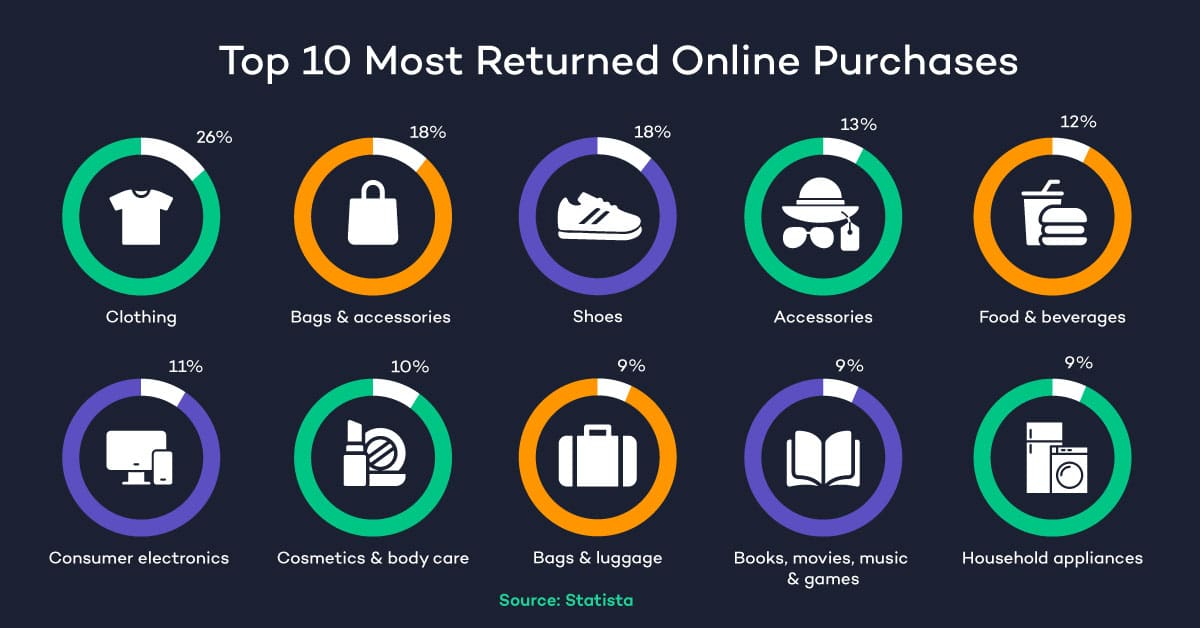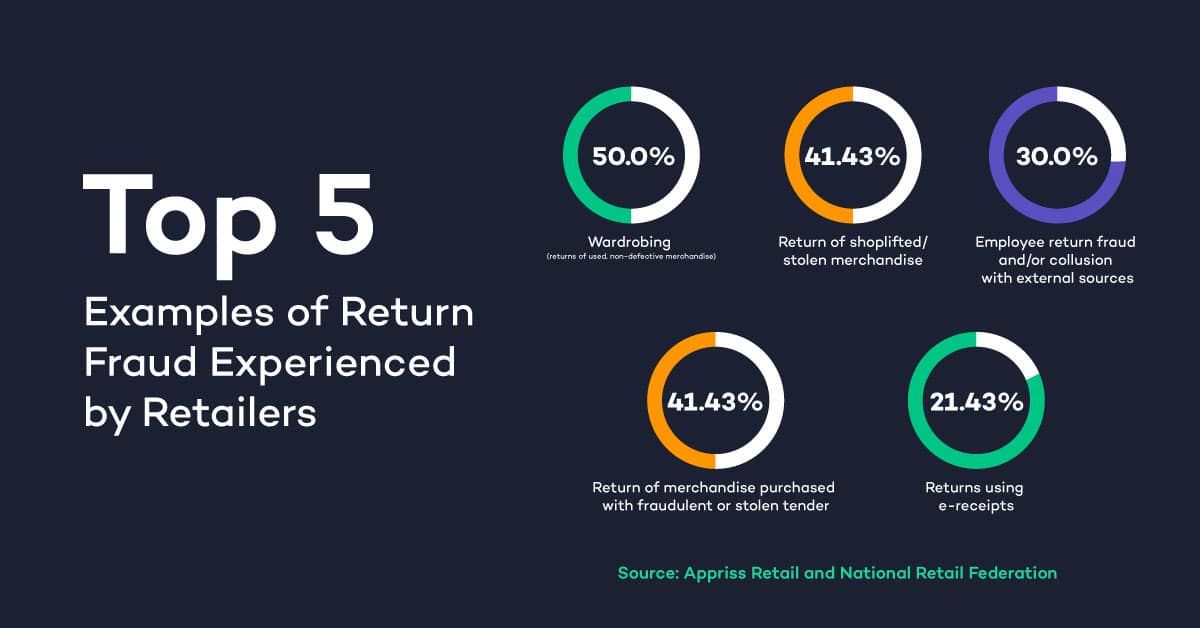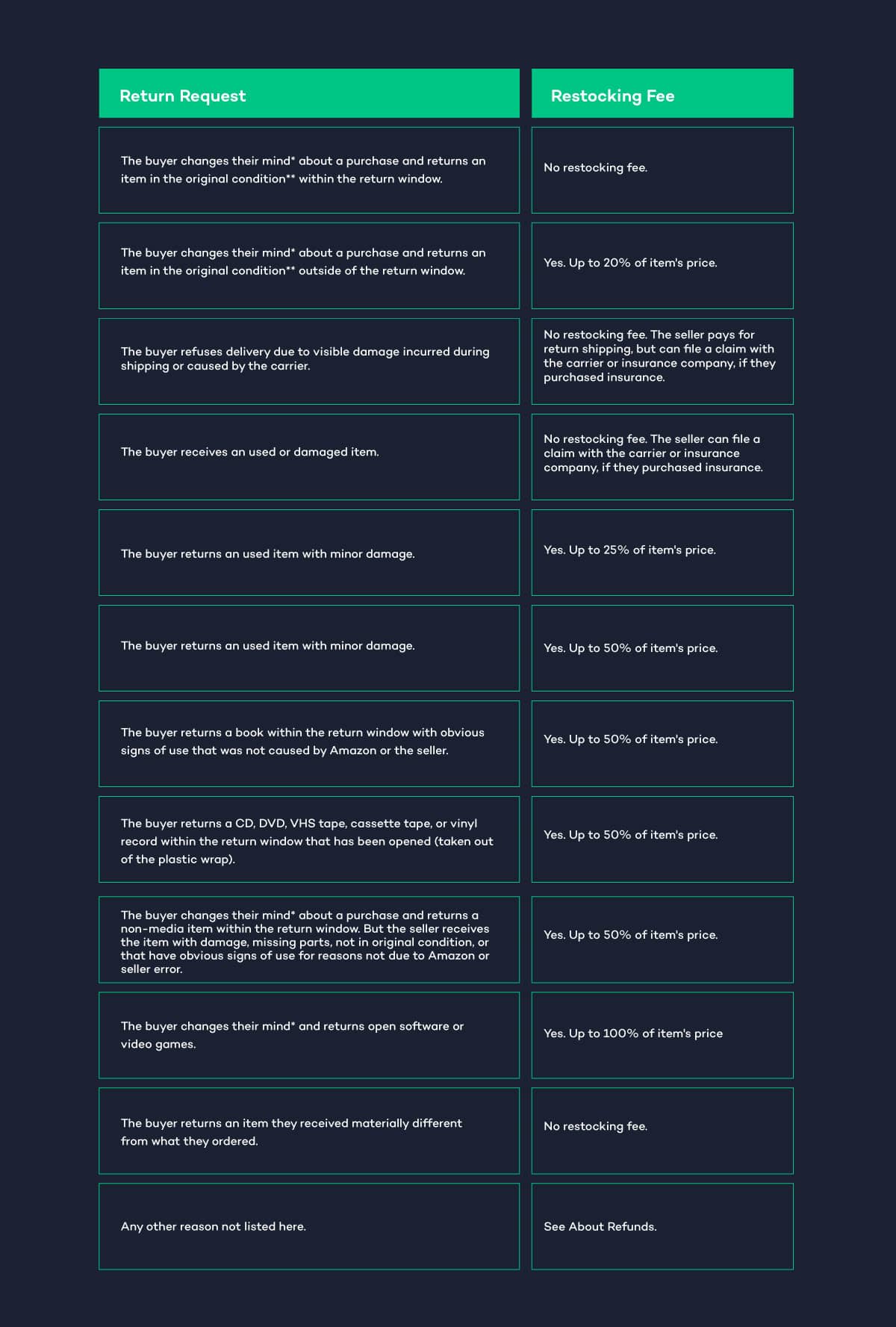Selling on Amazon allows online sellers and entrepreneurs to reach more customers on a global scale. Order volumes can drastically increase as many shoppers consider the Amazon marketplace their go-to online shopping platform.
However, with an increased volume of Amazon orders due to the influx of shoppers, Amazon returns are to be expected. You might experience product returns, especially during the peak holiday shopping season. For that matter, it would be beneficial for sellers to familiarize themselves with Amazon return policies.
A Closer Look Into Retail Industry Customer Returns
Online purchases from any eCommerce store, including Amazon, come with their own set of challenges leading to product returns. Accordingly, eCommerce return rates are estimated to rest at around 20-30%, which is 2x to 3x higher than in-store purchases.
A recent survey highlighted clothing as the most returned online purchase, followed by other products and categories highlighted below:
According to the National Retail Federation, last year’s holiday product returns amounted to $171 Billion, and out of the said amount, $17.3 Billion were due to fraudulent returns. Accordingly, most retailers experienced return fraud in the form of:
Top Reasons That Drive Customer Product Returns
Understanding the dynamics behind product returns is crucial, especially in eCommerce. To better grasp the reasons for product returns, here are some of the factors influencing consumers to return their online purchases.
Incorrect Product Delivered
One of the reasons for product returns is receiving a different product from what customers actually ordered. Despite having a sophisticated fulfillment system, Amazon occasionally sends wrong packages to customers. This incorrect product shipment may result from inventory mistakes, including picking and packing of orders.
Mismatched Items Shipped Item Different From the Description
When selling on Amazon, you should be cautious in encoding product descriptions for each listing, especially if you have multiple variations for a single product. Online shoppers typically return orders that do not match the product descriptions or images on the website, leading to dissatisfaction and mistrust.
Size and Fit Issues
As mentioned earlier, clothing is often cited as one of the product categories experiencing product returns. The reason behind this is usually associated with fitting or sizing issues. Size discrepancies or poor fitting leads customers to return purchased items, which is why charts and detailed product information are crucial.
Order Quality Issues
Damage or defective items is another reason why Amazon shoppers return their orders. It usually occurs for products that require assembly or those electronics-related. Quality control and accurate product descriptions are essential to avoid such an occasion of Amazon returns.
Late Delivery
Shipping delivery period is crucial for any online retail business, for any delay may prompt customers to return their orders as they may no longer need the item by the time it arrives.
Damaged in Transit
Items can also be damaged while in transit, leading to product returns. In order to minimize such a concern, you should secure the product package and partner only with reliable carriers or logistics companies.
Price Comparison Shopping
Price comparison is another reason why customers tend to return their orders. They will likely return their orders once they find a more competitively priced item online. Even though Amazon no longer offers price matching, shoppers may resort to providing inaccurate or false justifications for their returns in such cases.
To address this issue, implementing price optimization can be helpful for your business. Amazon sellers can take advantage of Amazon repricers or AI repricing software to automate price adjustments.
In order to avoid or minimize instances of Amazon shoppers returning their orders, it is essential to effectively manage aspects of the business that you can control, such as pricing, product listing, and product quality. Nevertheless, if returns become unavoidable, becoming well-acquainted with Amazon’s return policy can be a valuable resource for efficiently handling product returns.
Essential Insights into Amazon FBA’s Return Policy
To better handle FBA product returns, you should familiarize yourself with FBA return policies. Here are some important points you should know about Amazon’s return policy for FBA sellers.
Amazon Return Policy Exceptions
As per Amazon, items purchased by shoppers can be returned within 30 days of delivery, with some exceptions, including those items deemed non-returnable by Amazon, and these include the following:
- Digital items such as Open software and Downloadable software products;
- Cards such as game cards and prepaid game cards; Devices such as laptops, desktops, and kindles more than 30 days after delivery;
- Products that are unsafe for return, including hazardous materials or items that utilize flammable liquids or gasses.
Other Amazon products that are deemed unreturnable but may be eligible for refund or replacement include the following:
- Amazon Fresh and Grocery Items
- Amazon Pharmacy Items
- Amazon Photos Items
- Amazon Bulk Liquidations Store Items
Return Evaluation
To avoid confusion, Amazon defines a “return” as an item a customer sends back to a fulfillment center, and each item that is returned undergoes an evaluation process to determine its quality, whether it is still sellable or not.
For items deemed sellable, they will be returned to the seller’s inventory. On the other hand, items returned that are considered unsellable will be removed from the fulfillment center. Items are classified as unsellable if they are:
- Not in the same condition as previously listed.
- Defective, damaged, opened, lacking required labeling, prohibited, or otherwise unsuitable.
- Posing health or safety risks to Amazon associates or future customers
Non-Volatile Internal Memory
When dealing with products including non-volatile internal memory, like digital cameras, if there are any indications of use, they will be classified as unfulfillable. In such situations, Amazon’s return policy recommends formatting the memory before reintroducing the item into the seller’s inventory.
Removal Orders
For returned items categorized as defective or customer-damaged, you must submit a removal order within 30 days after the returned item arrives at the fulfillment center. Alternatively, you can request Amazon to return or dispose of your unsellable inventory automatically.
Return Time Frame
Amazon customers can initiate a return request within 30 days of their order’s delivery. Nonetheless, Amazon may exercise discretion and consider accepting return requests that exceed the initial 30-day timeframe on a case-by-case basis.
Amazon FBM or Seller-Fulfilled Returns Policy
Like FBA sellers, FBM sellers must adhere to Amazon’s return policy for seller-fulfilled orders. Sellers operating on Amazon should understand the Amazon return policy and its implications for FBM sellers, as these return policies affect how they handle returns and interact with customers. Here are some key points about this Amazon return policy specific to FBM sellers.
Return Authorization
While Amazon automatically grants US return requests for items that fall within the Amazon return policy, some products require manual authorization from sellers. These items listed below are automatically exempt from prepaid return labels:
- Handmade
- Certified pre-owned watches
- Non-physical items (for example, warranties, digital software, or digital coupons)
- Items that are non-returnable by law and dangerous goods
To manually review return requests for items outside Amazon’s return policy or those considered category-exempt, FBM sellers can follow the steps outlined below.
STEP 1: Login into your Amazon Seller Central account. Once you are logged in, on the menu section, select Orders > Manage Returns.
STEP 2: Once you are on the “Manage Returns” page, look for the “Pending Actions” tab and search by “Pending Authorization.” To authorize a single return request, select the request you want to review.
It is worth noting that when authorizing return requests, sellers can either use the Return Merchandise Authorization (RMA) number or enter a custom RMA number. Moreover, sellers can use either an Amazon-generated unpaid return label or upload their custom prepaid return label when approving an Amazon shopper’s return request.
Response Time
Since Amazon is a customer-centric company, you should take into account your response time concerning manual authorization for Amazon returns. Amazon requires FBM sellers to respond to return requests needing manual authorization within 24 hours. Promptly responding to such a return request helps increase customer satisfaction, which could result in positive reviews.
Refund Issuance
In response to a product return, Amazon sellers can issue a refund. For FBM sellers, you have two days to issue a refund following your receipt of the returned item. Alternatively, if you let the shopper keep the product, you can issue an Amazon refund immediately. If the seller has taken no action concerning the refund, Amazon might refund the customer and charge the amount to your seller account.
Prepaid Return Labels
As per Amazon’s return policy, seller-fulfilled orders come with prepaid returns for US sellers because they are automatically enrolled in the prepaid returns label program. This means that Amazon provides prepaid return shipping labels to shoppers on the seller’s behalf. Sellers should familiarize themselves with prepaid return policy to ensure that their return policies align with this practice.
Not all products are eligible for prepaid returns. There are some categories and subcategories that Amazon automatically exempts from prepaid return labels, and these include the following:
- Handmade
- Certified pre-owned watches
- Non-physical items (for example, warranties, digital software, or digital coupons)
- Items that are non-returnable by law and dangerous goods
- Extra large or heavy items
In such cases, FBM sellers can upload a merchant-paid return label. This can be important for managing returns of certain items that do not qualify for the prepaid label program.
Wrong Item Returned
If you are uncertain about what to do when customers ship back incorrect items rather than their original purchase, Amazon’s return policy stipulates that sellers must follow these instructions:
First, you must inform the Amazon customer that they might have accidentally returned the wrong item. Secondly, you should inquire whether they want the wrong item returned to them. If the buyer indicates that they would like the wrong item back, then you can return it to them.
Lastly, inform the customer that they can return or resend the correct item for a refund. You should inform your customer that a refund can take 3-5 days to reflect in the customer’s account to set their expectation.
Amazon FBM sellers should have a good understanding of Amazon’s return guidelines. Adhering to these rules and promptly addressing return requests is crucial for efficiently handling returns and upholding a favorable seller reputation on Amazon.
Amazon Return Policy 2024 Updates Sellers Should Be Informed Of
Amazon has introduced updates and adjustments to its return policy for this year. Here are a few of the crucial updates to Amazon’s return policy for 2024 that you should be aware of.
Amazon Returns Window Extended
Amazon recently announced that their standard Amazon returns window will be extended for the 2023 holidays.
As per Amazon, their 2023 Extended Holiday Returns policy “requires that items purchased between November 1, 2023, and December 31, 2023, are returnable through January 31, 2024, except for Apple brand products, which can be returned through January 15, 2024.”
This Amazon return policy for 2023 holidays applies to seller-fulfilled, FBA, and Amazon retail orders.
Expanded Returns Processing Fee
Effective June 1, 2024, sellers can anticipate an expanded returns processing fee, particularly for products with high return rates across all categories, excluding apparel and shoes, which will retain their existing fees on average. This adjustment to the returns processing fee aims to manage the operational expenses tied to Amazon returns and reduce waste.
Updated Manage Returns Tool
As Q4 2023 started, Amazon unveiled an enhanced version of the Manage Returns tool, designed to assist sellers in handling seller-fulfilled returns across multiple stores.
Before this update, sellers had to log into their Seller Central accounts separately for each store to handle returns. With this recent improvement, sellers can conveniently access and oversee customer returns from all the stores they operate within a single dashboard in 2024.
Amazon’s Return Policy – Frequently Asked Questions
Understanding Amazon’s return policy can be challenging, especially for new sellers. Here are responses to commonly asked questions by Amazon sellers regarding product returns regarding Amazon’s return policy.
What Can I Do With Returned Products at Amazon?
When dealing with Amazon returns, Amazon provides sellers with multiple options that help them reduce potential losses. Here are some Amazon programs to help you handle customer-returned items.
FBA Liquidation Program
This program is designed to help sellers recover value from returned items. Through FBA liquidation, you can choose to have returned items liquidated through an approved inventory liquidator.
When returned items are liquidated, you will get a portion of your inventory cost in the form of a net recovery value. Amazon stipulates that net recovery value will appear in your Amazon account within 60 days and no later than 90 days after your liquidation order is submitted.
FBA Grade and Resell Program
Rather than incurring costs for the removal of returned inventory, you have the option to re-list and sell qualified customer returns as “used,” thereby eliminating the need to cover costs for both inventory removal and storage of removed items.
It is worth noting that not all sellers have access to the FBA Grade and Resell program, as it operates on an invitation-only basis. Additionally, it is important to understand that product eligibility is limited to customer-returned inventory housed in fulfillment centers enabled for the FBA Grade and Resell program.
FBA Donations Program
In the event that you consider the returned item as unwanted FBA inventory and you do not want to pay for inventory removal, you can utilize the FBA Donations program. This Amazon program lets you donate your unwanted inventory to select US charities.
Sellers should also take note that not all products can be considered for donation. Amazon has stressed that an ASIN’s eligibility for donation is still subject to legal, safety, and regulatory standards. Some of the items that Amazon has identified as unsuitable for donation comprise:
- Dangerous goods (hazmat)
- Prohibited and restricted products
- Recalled products
- Products with internal memory
- Counterfeit products
- Products with safety concerns
- Defective or inappropriate for donation
What is an Amazon Returnless Refund?
An Amazon returnless refund means the seller can refund Amazon shoppers without requiring the shopper to send the product they intend to return. This approach serves as a returnless resolution and can be accessed under “Return Settings” on the Amazon Seller Dashboard.
What should be done if Amazon authorized a return or refund on your behalf that you believe should not have been authorized?
The seller has the option to file an appeal. It is a way for sellers to address situations where they believe a return is unjustified.
How can I dispute a refund issued by Amazon?
For sellers who think a refund has been incorrectly issued on your behalf by Amazon, sellers are eligible to file a claim for reimbursement. This can be processed under the Manage SAFE-T Claims tab.
What is an Amazon restocking fee?
A restocking fee is a fee that may be charged to customers who return certain types of Amazon products. The restocking fee covers the costs associated with processing returns, inspecting and testing returned products, and preparing them for resale.
As an overview of the restocking fee for each return request, here is a guideline to help you calculate the restocking fee for eligible items.
Implications of Amazon’s Return Policy
Amazon’s return policy influences Amazon sellers’ activities in various ways. The most significant impact of the Amazon return policy is that sellers are often required to accept returns and issue refunds. The primary goal of this return policy is to guide sellers on the appropriate procedures for managing and processing product returns.
Nevertheless, aside from strict adherence to the Amazon return policy, sellers must prioritize delivering outstanding customer service. This includes maintaining precise product descriptions to minimize, if not prevent, instances of Amazon returns and refunds.





